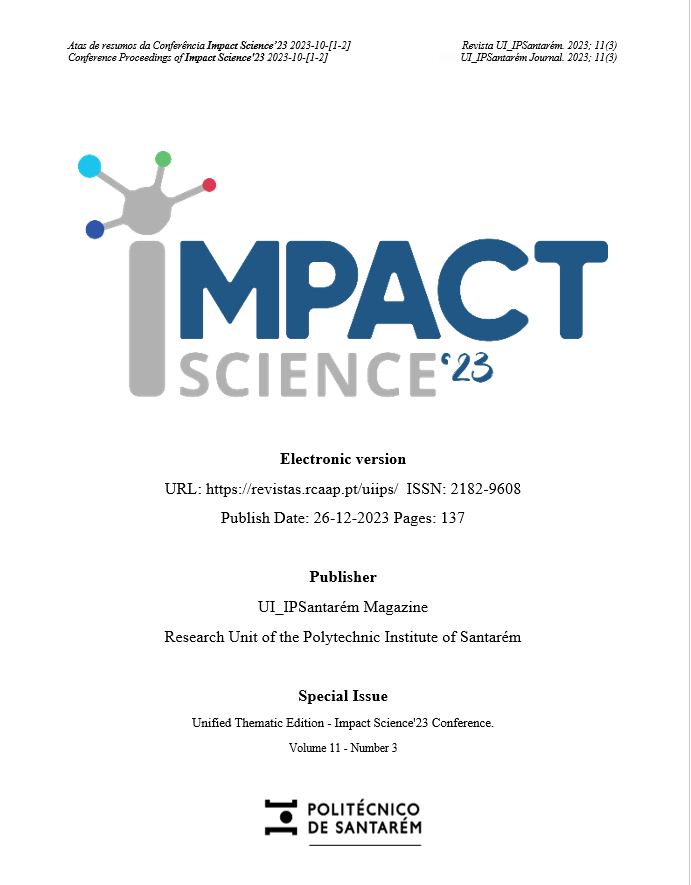Chitosan as a biostimulant component in nanofertilizers
DOI:
https://doi.org/10.25746/ruiips.v11.i3.32436Keywords:
biostimulator, fertilizers, phytotoxicity, watercressAbstract
The development of alternatives to conventional fertilizers has been gaining momentum in recent years. The need to feed the growing world population, the premises of sustainability that the world proposes and the effective need to combat the effects of climate change, are precursors of this change, along with the galloping prices that have been registered in production inputs. Thus, the development of nanofertilizers appears as an opportunity for the agricultural sector, in a logic of tailor-made solution and precision of application. The inclusion of biostimulants must be considered in order to increase the resistance and resilience of crops to the effects of anthropogenic changes, which are already being felt and will become worse in the coming years.
Chitosan is a biodegradable, biocompatible polysaccharide that has been used as a carrier for other agricultural compounds due to its biodegradable and non-toxic properties. Most commercial chitin, from which chitosan is derived, is produced from shrimp, prawn and crab waste. This compound is reported to have a biostimulant effect on crop immune systems, promoting antifungal, antiviral, bionematicidal effects and enhancing catalytic enzymes. Several studies have reported soil improvements after its use, such as increased water retention and removal of heavy metals, but also beneficial effects on water quality by controlling algal contamination. Since chitosan preparations are distinct from study to study, and the phytotoxicological component is often lacking, this study aimed to achieve a formulation of chitosan to be used in nanofertilizer pellets and to assess the effect on the germination of Lepidium sativum L.
Germination tests using Lepidium sativum L., are carried out according to the European standard EN 16086-2, where the root length index and the Munoo-Liisa vitality index are determined, allowing to qualify the level of phytotoxicity or the biostimulant effect of the compound. Two treatments are tested and compared with the control. In each mode, ten seeds were placed on a filter paper, in Petri dishes of 9 cm diameter and in quadruplicate. Then, 3 mL of solution are added and the petri dishes go to incubation at 25 ± 2 °C during 72 h. The images are treated with the software "Image J" and the analysis of variance was performed at 1 factor, being the multiple comparison of means obtained through the Tukey test (p<0.05).
It is not expected to find phytotoxic effect of the compound, but rather to confirm the biostimulant effect of chitosan, used in the present form, to incorporate in the final design of the nanofertilizer pellets under development.
This work is funded by the Fundação para a Ciência e Tecnologia under the PhD scholarship 2020.06559.BD, project PTDC/CTM-REF/2679/2020, UIDB/04462/2020, under the Nanofert project and under the LEAF-Linking Landscape, Environment, Agriculture and Food Research Unit project, UIDB/04129/2020.
Downloads
Published
How to Cite
Issue
Section
License
Copyright (c) 2023 Raquel Costa Saraiva, Quirina Ferreira, Gonçalo Caleia Rodrigues, Margarida Oliveira

This work is licensed under a Creative Commons Attribution-NonCommercial-NoDerivatives 4.0 International License.
Authors publishing in this journal agree to the following terms:
Authors retain copyright and grant the journal the right of first publication, with the article simultaneously licensed under the Creative Commons Attribution License that allows sharing of the work with acknowledgement of authorship and initial publication in this journal.
Authors are permitted to enter into additional contracts separately for non-exclusive distribution of the version of the article published in this journal (e.g., publish in an institutional repository or as a book chapter), with acknowledgment of authorship and initial publication in this journal.
Authors have permission and are encouraged to publish and distribute their work online (e.g., in institutional repositories or on their personal webpage) at any point before or during the editorial process, as this may generate productive changes, as well as increase the impact and citation of the published work.



